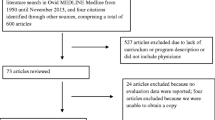Abstract
We studied the effects of the Interdisciplinary Leadership Development Program (ILDP) on MCH trainees from five MCHB-funded training programs at the UNC-Chapel Hill from the years 2001–2008. Specifically, we examined attitudes/beliefs about interdisciplinary practice and the frequency of use of interdisciplinary skills; identified effects of interdisciplinary training on career choices; and, examined the ways in which graduates used their interdisciplinary skills to effect change in MCH organizations and systems, up to 8 years after completion of training. Using a post-test design, participants in the ILDP were contacted to complete a web-based survey. Non-participating LEND and public health graduates were recruited for comparison. Guided by EvaluLEAD, we designed questions that asked graduates to rate the influence of their programs on their attitudes/beliefs and skills (on 5-point Likert scales), and to describe those influences in some detail in open-ended questions. The 208 respondents represented 59.6 % of the graduates from 2001 through 2008. Model-predicted mean levels of frequency of use of interdisciplinary skilIs was associated with ILDP participation (p = 0.008) and nearly so for interdisciplinary attitudes/beliefs (p = 0.067). There is an association between four domains of systems changes and frequency of skill use: develop/improve a program (3.24 vs. 2.74, p < 0.0001); improve the way an organization works (3.31 vs. 2.88, p < 0.0001); develop/improve a partnership (3.22 vs. 2.83, p < 0.0003); and, develop a policy (3.32 vs. 2.98, p < 0.0013). Graduates used interdisciplinary training to improve outcomes for families and to effect change in MCH systems. MCH leaders should disseminate, more broadly, rigorous assessments of the training intended to develop leadership competencies that underpin effective interdisciplinary practice.

Similar content being viewed by others
References
Kreider, R., & Elliott, D. (2009). America’s families and living arrangements: 2007 P20-561. Current Population Reports.
Goulding, M., Rogers, M., & Smith, S. (2003). Public health and aging: trends in aging—United States and worldwide. MMWR, 52, 101–106.
Frey, W. (2012). America reaches its demographic tipping point. Demographics, ethnicity, race, children and families. Brookings Institution. February 9.
Boyle, C., Boulet, S., Schieve, L., Cohen, R., Blumberg, S., Yeargin-Allsopp, M., et al. (2011). Trends in the prevalence of developmental disabilities in US children, 1997–2008. Pediatrics, 127, 1034–1042.
Dodds, J., Vann, W., Lee, J., Rosenberg, A., Rounds, K., Roth, M., et al. (2010). The UNC-CH MCH Leadership Training Consortium: Building the capacity to develop interdisciplinary MCH leaders. Maternal and Child Health Journal, 14, 642–648.
MCH Leadership Competencies Workgroup (Eds). (2009). Maternal and child health leadership competencies. June 2009.
Athey, J., Kavanagh, L., & Bagley, K. (2001). The MCH Training Program: an evaluation. Arlington, VA: National Center for Education in Maternal and Child Health.
Cooper, H., Carlisle, C., Gibbs, T., & Watkins, C. (2001). Developing an evidence base for interdisciplinary learning: A systematic review. Journal of Advanced Nursing, 35(2), 228.
Hammick, M., Freeth, D., Koppel, I., Reeves, S., & Barr, H. (2007). A best evidence systematic review of interprofessional education: BEME Guide no. 9. Medical Teacher, 29(8), 735–751.
Reeves, S., Zwarenstein, M., Goldman, J., Barr, H., Freeth, D., Hammick, M., et al. (2008). Interprofessional education: effects on professional practice and health care outcomes. Cochrane Database of Systematic Reviews, 23(1), CD002213.
Remington, T. L., Foulk, M. A., & Williams, B. C. (2006). Evaluation of evidence for interprofessional education. American Journal of Pharmacy Education, 70(3), 66.
Hall, P., & Weaver, L. (2001). Interdisciplinary education and teamwork: A long and winding road. Medical Education, 35(9), 867–875.
Grove, J., Kibel, B., & Haas, T. (2005). EvaluLEAD: A guide for shaping and evaluating leadership development programs. Oakland: W.K. Kellogg Foundation and Public Health Institute.
Patton, M. (1990). Qualitative research and evaluation methods. Thousand Oaks: Sage.
Acknowledgments
We would like to thank our colleagues, Kathleen Rounds, Jan Dodds, Michael Milano, Bill Vann, and Jessica Lee, whose commitments to interdisciplinary training and practice were essential to the completion of this project. We also express our appreciation for the thoughtful participation of the graduates of our programs. Mike Hussey provided excellent statistical support. This research was supported by HRSA/MCHB grant R40MC08558.
Author information
Authors and Affiliations
Corresponding author
Rights and permissions
About this article
Cite this article
Margolis, L.H., Rosenberg, A., Umble, K. et al. Effects of Interdisciplinary Training on MCH Professionals, Organizations and Systems. Matern Child Health J 17, 949–958 (2013). https://doi.org/10.1007/s10995-012-1078-8
Published:
Issue Date:
DOI: https://doi.org/10.1007/s10995-012-1078-8




